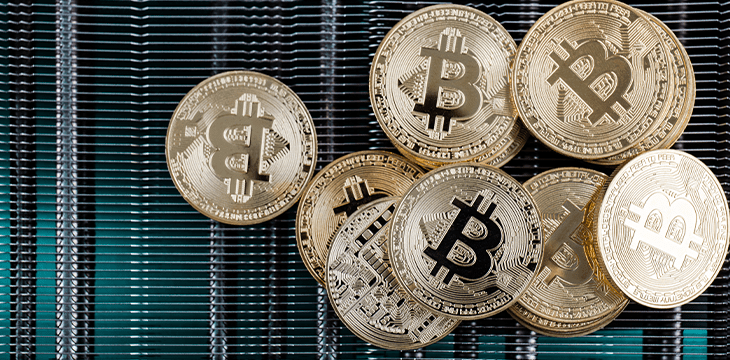|
Getting your Trinity Audio player ready...
|
With the advent of computers, smartphones, and the Internet, fiat money became digitized. Marquez Comelab discusses how Bitcoin pushed the evolution of money and describes how it electronifies a monetary and cash system without the need for intermediaries and go-betweens (like banks) to facilitate transactions between people. In this article, Marquez explains the most fundamental elements of Bitcoin and how it operates to help most people gain the necessary background to understand and start exploring Bitcoin.
The last 40 years brought about the rapid development and use of computers, smartphones, and the Internet. Money is no longer just coins and paper notes. Fiat money has been digitized1: It has been converted to 1s and 0s that can be stored, processed, and transmitted across telecommunication networks. This transformation has made it easier, faster, and cheaper for many people to transact not only regionally but globally. However, despite fiat currencies having acquired some advantages that digitization has brought, the monetary system that supports it still relies entirely on governments and institutions to be regulated, managed, and operated to function, which presents several challenges.
Many governments have fallen prey to printing too much money over the last century, bringing disastrous incidences of hyperinflation that have collapsed economies worldwide. Further, for many entrepreneurs and businesses, the setup costs to accept payments and the transaction costs continue to eat away a sizeable percentage of their startup budget, earnings, and revenues. In many parts of the world, access to the financial system and the payment systems the wealthier nations use is inaccessible due to the high costs of making such things possible in countries with corrupt governments and weak institutions. These factors reduce and limit the ability of many people around the world to improve their lives.
On October 31, 2008, a link to a paper titled, “Bitcoin: A Peer-to-Peer Electronic Cash System,” was posted to a mailing list on the Internet. The paper described how it is possible to create an electronic cash system that can operate peer-to-peer: without the need for central banks, governments, or any other intermediaries to facilitate or manage the creation and transfer of money between two users anywhere in the world.
The Bitcoin white paper was authored by Satoshi Nakamoto, a mysterious figure who only communicated and worked with computer professionals online to develop the Bitcoin protocol. He eventually implemented the Bitcoin software as open-source code in January 2009, which gave birth to Bitcoin. He never revealed his real identity before he stopped all correspondence and disappeared in 2010.
Timestamping all transactions around the world
Satoshi Nakamoto described how his vision could be achieved by timestamping every transaction in the world, ordered in the sequence they occurred. Every 10 minutes, the details of all transactions in the network are compiled into a block of data. This block is then joined to the previous block that was compiled 10 minutes earlier. These blocks of 10-minute data are connected chronologically, making up a blockchain. Therefore, this blockchain is a record of truth, providing an evidence trail that proves details of transactions. In such a system, we no longer need banks purely for the sole reason of executing our transactions, keeping records of them, and tallying how much we have in our bank accounts. With Bitcoin, this information is verifiable on this public record—the blockchain.
Distributed and decentralized
The Bitcoin network is not owned, maintained, operated, or controlled by a single government, bank, or entity. Copies of the blockchain are stored and maintained by computers called nodes/miners distributed anywhere and everywhere worldwide. If one miner stops for whatever reason, other miners will take its place and ensure the transactions’ records on the blockchain are always maintained and accessible. This makes it extremely difficult for a single nation or a group of institutions and/or individuals to manipulate transaction data.
Anybody can buy a mining computer and start mining to maintain the blockchain. In return for this valuable service, miners receive bitcoins2 from the Bitcoin protocol that has been programmed to reward miners who successfully add a block to the blockchain. Mining is the only way new bitcoins are injected into the global economy.
Proof-of-work
What entitles a miner to the privilege of adding a block to the blockchain and earning the bitcoin reward? Here, Satoshi Nakamoto proposes an incentive system based on competition and meritocracy. Every 10 minutes, miners in the Bitcoin network compete to solve a mathematical problem. When they are the first to solve this problem, they get to add a block to the blockchain and, therefore, receive the Bitcoin reward. A struggle, therefore, exists between mining businesses to have the best computing resource available.
Limited Supply—21 million bitcoins, or 2.1 quadrillion satoshis
There are 100 cents to a dollar. There are 100,000,000 satoshis to a bitcoin. There will only ever be 21,000,000 bitcoins in existence. This is equivalent to 2,100,000,000,000,000 satoshis.
The 21 million supply limit is encoded in the Bitcoin protocol. It stops Bitcoin from inflating (devaluing). This ensures the stability and predictability of its supply and has profound implications regarding its buying power. All things being equal, its buying power strengthens over time. That is, you can buy more with one bitcoin over time. Fiat currencies do the opposite. You get to buy less over time because their purchasing power weakens as the central banks print more money.
The distribution of Bitcoins and other rewards
Miners make money from two sources: the reward they receive when they successfully add a block to the blockchain and transaction fees. The reward given to miners started at its maximum, at a generous 50 bitcoins per block. Every four years, the protocol has been programmed to half the reward. Once the 21 million bitcoins have been distributed, miners will have to rely on transaction costs as their revenue stream. This incentivizes miners and businesses to support the ecosystem and invest early, where the rewards are more significant in the number of bitcoins earned.
The early miners, who owned the first bitcoins, used the new digital currency to buy more mining equipment and other goods and services to maintain or expand their businesses from others who, like them, believed Bitcoin would become valuable and useful. As Bitcoin functioned continuously without the network ever going down and without bitcoins ever being stolen at the blockchain level3, confidence in its security and functionality grew. Eventually, people started using bitcoin as a currency, leading to a famous transaction on May 22, 2010, when Laszlo Hanyecz purchased a pair of Papa John pizzas for 10,000 bitcoins.
Transparency, privacy, and non-anonymity
All transactions are stored, accessible and visible on the blockchain. When you look at the data on a blockchain using a blockchain explorer, you see the details of transactions—how many satoshis went from one Bitcoin address to another, at what time. This has implications, and it opens possibilities.
Bitcoin provides a level of transparency that makes it easier to prepare, report, and audit financial statements. Bitcoin addresses add a layer of privacy by not identifying which individual owns or controls it. However, it should NOT be mistaken for a system that provides anonymity. There are laws and processes exist that require us to disclose our identities. Such is the case when we buy a house, a car, book a hotel, and even simple things like registering for memberships or filling out warranty cards or loyalty cards. If Bitcoin is used to purchase an item where the person discloses their identity, Bitcoin addresses can eventually be traced to individuals.
The blockchain, therefore, provides the means which make it easier to catch criminals, dishonest workers, fraudulent executives, terrorists, or corrupt officials. Many early users of Bitcoin who misunderstood this and used Bitcoin for illegal activities were later caught by law enforcement who used the information available on the blockchain as part of their investigations.
Using Bitcoin is like using your bank app
On the more practical side, if you have not sent or received bitcoins before, here is a simplified comparison between using the current monetary system and Bitcoin. I have the Bitcoin Satoshi Vision (BSV) blockchain/project in mind when writing this because it follows Satoshi Nakamoto’s vision and original protocol of Bitcoin. The “Bitcoin” blockchain/project, identified as BTC, has modified its protocol, and some statements here may not apply.
|
|
|
|
You choose a bank. Your bank acts on your behalf to interact with the banking network. If you live in a country where banking is too expensive or inaccessible, you cannot proceed. |
All you need is a computer or a smartphone and access to the Internet. You choose a wallet4. Wallets are developed by software developers. They are your way of interacting with the Bitcoin network. There are many wallets you can use. If you do not like one, you can try another. |
|
You create a bank account. You need to provide your private and confidential details to banks before they approve. |
You create a Bitcoin address, also called a public key. You can create one in seconds because you do not have to provide confidential or sensitive information5. |
|
You download an app or go to your bank’s website. The app or the website shows your transaction history and your balance. |
You download the wallet or go to the wallet provider’s website. The app or the website shows your transaction history and your balance. If the wallet provider goes bankrupt and shuts down, you can access your blockchain information with another wallet provider. |
|
You send money to the recipient’s bank account number. |
You send bitcoin to the recipient’s Bitcoin address. |
|
To transact, you need to have a password to access your bank account through your bank’s app/website. |
To transact, you need to have a private key issued along with your public key (your Bitcoin address) when you set up your wallet. |
|
Transactions go through the banking system, usually taking three working days to settle. |
Transactions go through the Bitcoin network, usually taking from a few seconds to 20 minutes to get confirmed, regardless of where the sender and receiver are in the world.6 |
|
Your bank closes during holidays and weekends. |
The Bitcoin network has been up and has never been down since it went live in 2009. You can transact 24 hours a day, seven days a week. |
|
Banks can go bankrupt. Many of them have been hacked and funds have been stolen over the last decade. |
If a wallet provider goes bankrupt, you use another wallet and can still access your bitcoin wallet/address stored on the blockchain7. If a miner goes bankrupt or stops, Bitcoin simply uses another miner somewhere in the world. The Bitcoin network has not been hacked since its launch. (By ‘hack,’ we mean money double-spent or stolen by a 51% attack.) |
|
Your bank is an INTERMEDIARY acting on your behalf so you can access the monetary and financial system. They have a fiduciary relationship with you. They have the power to block your transactions and suspend your account. |
‘Peer-to-peer’ implies there are no INTERMEDIARIES necessary to carry out transactions between two users. The miners and wallet providers are not INTERMEDIARIES in the way that banks are, and they have no fiduciary relationship with you. Wallets merely work on your request to send or receive bitcoins. Miners add transactions like yours to the blockchain. With Bitcoin, you act directly with the Bitcoin monetary/cash system, without the need for a middleman. |
[Please note that the above is NOT intended as a complete and nuanced set of instructions on creating Bitcoin wallets and transacting in Bitcoin. Please complement this resource with additional research before you begin transacting Bitcoin.]
Conclusion:
As we mentioned above, fiat money operates under a monetary system that requires governments and central banks to be actively involved in decisions involving its creation, maintenance, and operation. Bitcoin is more than just a digital currency like digitized fiat currencies. After Satoshi Nakamoto kickstarted Bitcoin by issuing bitcoins and mining the first block of the blockchain, the Bitcoin is operated automatically by the Bitcoin protocol/software.
The concept of ‘electronification’ is much more than just converting analog items into digital. “While it incorporates elements of digitization, electronification pertains to the automation process.”8 In many ways, therefore, Bitcoin represents the electronification of money. Even if no artificial intelligence or machine learning technologies are involved, Bitcoin automates much of the processes needed to facilitate direct transactions between users. In this sense, we get a deeper appreciation of why Satoshi Nakamoto called Bitcoin a Peer-to-Peer Electronic Cash System for the planet.
***
REFERENCES:
[1] Source: “Definition of Digitization – IT Glossary | Gartner”, https://www.gartner.com/en/information-technology/glossary/digitization, last accessed January 8, 2022.
[2] Bitcoin is used as a proper/name noun with a capital B to refer to the Bitcoin protocol, the Bitcoin network, etc., while bitcoin beginning in a small ‘b’ is used to refer to the use of the currency (e.g.: John sent two bitcoins to James).
[3] I say blockchain level because readers might have heard about Bitcoin exchanges or wallets being hacked. Those types of incidences are not the same as the actual Bitcoin blockchain being controlled by 51% of miners, working together undo or changing the details of transactions that were already recorded and confirmed on the blockchain, and transferring it to a Bitcoin address they control. When Bitcoin exchanges and wallets are hacked, and bitcoins are reported to be stolen from those exchanges or wallets, that has to do with how those exchanges and wallets secure their systems. They are not indications that the security of the Bitcoin system itself has been breached.
[4] There are distinctions between different types of wallets. I am referencing live/hot wallets as opposed to something like cold storage (paper wallets).
[5] Because transactions in Bitcoin are visible to anyone who accesses the blockchain, it is recommended to use a Bitcoin address only once for your security, confidentiality, and privacy. This means you’ll be creating multiple addresses the more you transact.
[6] This is still the case with Bitcoin Satoshi Vision (BSV), the Bitcoin blockchain that still follows Satoshi Nakamoto’s vision and original protocol. BTC no longer does, and it is subject to heavy congestion and delays when its blocks become full.
[7] Check that your wallet provides you with the private key of your Bitcoin address so that you are indeed using a Bitcoin address that you can always access on the blockchain, and you are not reliant on that wallet or wallet provider.
[8] “Digitization vs. Electronification…What’s the Difference?”, https://orbograph.com/digitization-vs-electronification-whats-the-difference/, last accessed January 8, 2022).

 12-24-2025
12-24-2025 




